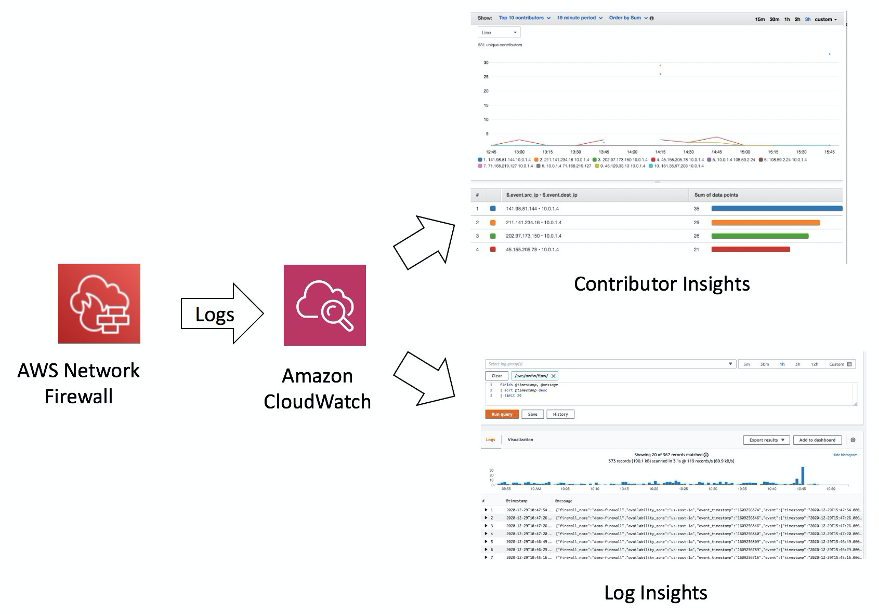AWS Cloud Operations Blog
Category: Advanced (300)
How to automate capture and analysis of CI/CD metrics using AWS DevOps Monitoring Dashboard solution
Across the world, organizations are investing in DevOps tools to improve productivity in their software delivery process. Customers tell us that they want to collect performance and operational metrics on their continuous integration/continuous delivery (CI/CD) pipeline, to quantify value from DevOps automation investments and to identify opportunities to improve efficiency in software delivery capabilities. However, […]
Use Contributor Insights to analyze AWS Network Firewall
AWS recently launched AWS Network Firewall, a stateful, managed network firewall that provides intrusion detection and prevention for Virtual Private Cloud (Amazon VPC). In a large-scale enterprise environment, it can be difficult and time-consuming to inspect multiple log groups and log streams. Investigating a security incident across a Network Firewall fleet that spans different VPCs […]
Introducing TypeScript support for building AWS CloudFormation resource types
If you’ve authored private resource types to extend the AWS CloudFormation registry, you might have used Java, Python, or Go, which, until now, were our officially supported languages. In this blog post, we will show you how to create a private resource type using TypeScript, the latest addition to our growing list of officially supported […]
Automate suspension of an AWS CodePipeline release during critical events using AWS Systems Manager Change Calendar and Amazon EventBridge
In this blog post, I show you how to set up public holidays calendars using AWS Systems Manager Change Calendar and suspend your AWS CodePipeline pipelines during the critical holidays in these calendar events. For example, let’s say an application release pipeline in your AWS account builds and deploys a new version of the application […]
Multi-step API monitoring using Amazon CloudWatch Synthetics
As customers add more applications, the number of APIs and webpages increase exponentially. The new multi-step HTTP monitoring in Amazon CloudWatch Synthetics offers visibility and helps you proactively solve problems. It helps engineering teams monitor their APIs 24/7 using flexible scripts so that they can maintain SLA compliance. In this post, we show you how […]
Use AWS License Manager APIs for the bulk import of license configurations and entitlements
When customers migrate workloads to the cloud, they can often substantially reduce costs by using their existing software licenses. AWS License Manager makes it possible for customers to allocate their existing licenses to their cloud-hosted workloads, enforce licensing rules to avoid falling out of compliance, and automate the tracking and management of the resources that […]
Deep Dive on AWS CloudFormation Macros to transform your templates
AWS CloudFormation macros add custom operations to your templates, including iterations, string manipulations, and math operations. Macros allow these language extensions without sacrificing the declarative benefits enjoyed by our customers, whether they are novice developers or experienced system admins. CloudFormation macros are ideal for system administrators and developers who benefit from the additional logic to […]
Use AWS CloudFormation Macros to create multiple resources from a single resource definition
AWS CloudFormation macros are used for the custom processing of your template. They use the features of imperative programming, which are not natively available while writing CloudFormation templates. In this blog post, I show you how to create and deploy a CloudFormation macro that provisions identical resources iteratively and uses a unique resource property to […]
Using AWS Cost and Usage Reports and Cost Allocation Tags to understand VPC Flow Logs data ingestion costs in Amazon S3
AWS customers enable the VPC Flow Logs feature in their accounts for security, governance, and auditing. They often have several teams who create VPC flow log subscriptions for their workloads and publish the data to the same Amazon Simple Storage Service (Amazon S3) bucket as part of a centralized logging architecture. Customers need a way […]
Use AWS License Manager and AWS Systems Manager to discover SQL Server BYOL instances
Most enterprises find it hard to maintain control of the commercial licensing of Microsoft, SAP, Oracle, and IBM products due to limited visibility. They wind up over-provisioning licenses to avoid the headache with third party license providers or under-provisioning licenses, only to be faced with steep penalties. If your enterprise uses AWS, you can address this […]









